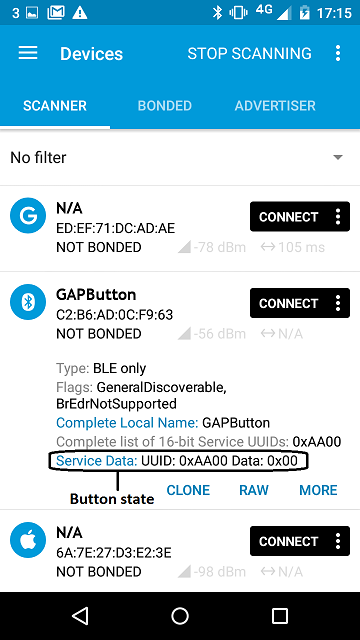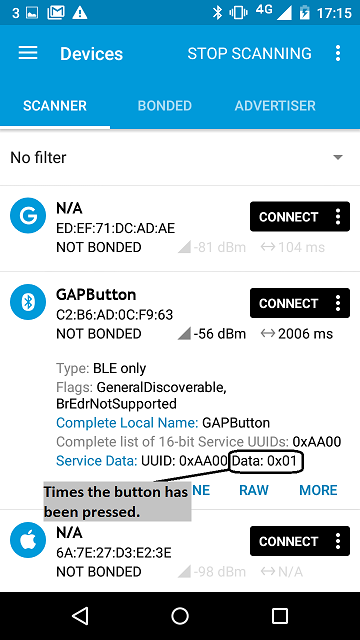This application shows how to use GAP to transmit a simple value to disconnected peer listening for advertisement every time that a value is updated. The canonical source for this example lives at: https://github.com/ARMmbed/mbed-os-example-ble/tree/master/BLE_GAPButton
Button count over GAP
This application shows how to use GAP to transmit a simple value to disconnected peer listening for advertisement every time that a value is updated:
- The value is a count of how many times a button on the device was pressed (the code actually monitors the button's releases, not press downs).
- We transmit the value in the SERVICE_DATA field of the advertising payload.
Running the application
Requirements
The sample application can be seen on any BLE scanner on a smartphone. If you don't have a scanner on your phone, please install :
- nRF Master Control Panel for Android.
- LightBlue for iPhone.
Hardware requirements are in the main readme.
Building instructions
Building with mbed CLI
If you'd like to use mbed CLI to build this, then you should refer to the main readme. The instructions here relate to using the developer.mbed.org Online Compiler
In order to build this example in the mbed Online Compiler, first import the example using the ‘Import’ button on the right hand side.
Next, select a platform to build for. This must either be a platform that supports BLE, for example the NRF51-DK, or one of the following:
List of platforms supporting Bluetooth Low Energy
Or you must also add a piece of hardware and the supporting library that includes a Bluetooth Low Energy driver for that hardware, for example the K64F or NUCLEO_F401RE with the X-NUCLEO-IDB05A1
List of components supporting Bluetooth Low Energy.
Once you have selected your platform, compile the example and drag and drop the resulting binary onto your board.
For general instructions on using the mbed Online Compiler, please see the mbed Handbook
Checking for success
Note: Screens captures depicted below show what is expected from this example if the scanner used is nRF Master Control Panel version 4.0.5. If you encounter any difficulties consider trying another scanner or another version of nRF Master Control Panel. Alternative scanners may require reference to their manuals.
- Build the application and install it on your board as explained in the building instructions.
- Open the BLE scanner on your phone.
- Start a scan.

figure 1 How to start scan using nRF Master Control Panel 4.0.5.
- Find your device; it should be named `GAPButton`; and look at the advertisement broadcasted by your device (there is no need to connect to your device).

figure 2 Scan results using nRF Master Control Panel 4.0.5.
- The Service Data field of the advertisement packet broadcasted by your device reflects the button press count. The starting value is 0.

figure 3 Initial state of the button using nRF Master Control Panel 4.0.5.
- Press the button on the device.

figure 3 State after 1 button press using nRF Master Control Panel 4.0.5.
- The Service Data field value of the advertisement packet should change every time you press the button.

figure 3 State after 6 button press using nRF Master Control Panel 4.0.5.
Note
Since broadcasting is not reliable and your phone may scan intermittently, it is possible that your phone will miss button updates.
source/main.cpp
- Committer:
- mbed_official
- Date:
- 2017-05-10
- Revision:
- 30:217bfc94a9b7
- Parent:
- 14:332bb3fa072b
- Child:
- 47:70f571463f31
File content as of revision 30:217bfc94a9b7:
/* mbed Microcontroller Library
* Copyright (c) 2006-2013 ARM Limited
*
* Licensed under the Apache License, Version 2.0 (the "License");
* you may not use this file except in compliance with the License.
* You may obtain a copy of the License at
*
* http://www.apache.org/licenses/LICENSE-2.0
*
* Unless required by applicable law or agreed to in writing, software
* distributed under the License is distributed on an "AS IS" BASIS,
* WITHOUT WARRANTIES OR CONDITIONS OF ANY KIND, either express or implied.
* See the License for the specific language governing permissions and
* limitations under the License.
*/
#include <events/mbed_events.h>
#include <mbed.h>
#include "ble/BLE.h"
DigitalOut led1(LED1, 1);
InterruptIn button(BLE_BUTTON_PIN_NAME);
uint8_t cnt;
// Change your device name below
const char DEVICE_NAME[] = "GAPButton";
/* We can arbiturarily choose the GAPButton service UUID to be 0xAA00
* as long as it does not overlap with the UUIDs defined here:
* https://developer.bluetooth.org/gatt/services/Pages/ServicesHome.aspx */
#define GAPButtonUUID 0xAA00
const uint16_t uuid16_list[] = {GAPButtonUUID};
static EventQueue eventQueue(/* event count */ 16 * EVENTS_EVENT_SIZE);
void print_error(ble_error_t error, const char* msg)
{
printf("%s: ", msg);
switch(error) {
case BLE_ERROR_NONE:
printf("BLE_ERROR_NONE: No error");
break;
case BLE_ERROR_BUFFER_OVERFLOW:
printf("BLE_ERROR_BUFFER_OVERFLOW: The requested action would cause a buffer overflow and has been aborted");
break;
case BLE_ERROR_NOT_IMPLEMENTED:
printf("BLE_ERROR_NOT_IMPLEMENTED: Requested a feature that isn't yet implement or isn't supported by the target HW");
break;
case BLE_ERROR_PARAM_OUT_OF_RANGE:
printf("BLE_ERROR_PARAM_OUT_OF_RANGE: One of the supplied parameters is outside the valid range");
break;
case BLE_ERROR_INVALID_PARAM:
printf("BLE_ERROR_INVALID_PARAM: One of the supplied parameters is invalid");
break;
case BLE_STACK_BUSY:
printf("BLE_STACK_BUSY: The stack is busy");
break;
case BLE_ERROR_INVALID_STATE:
printf("BLE_ERROR_INVALID_STATE: Invalid state");
break;
case BLE_ERROR_NO_MEM:
printf("BLE_ERROR_NO_MEM: Out of Memory");
break;
case BLE_ERROR_OPERATION_NOT_PERMITTED:
printf("BLE_ERROR_OPERATION_NOT_PERMITTED");
break;
case BLE_ERROR_INITIALIZATION_INCOMPLETE:
printf("BLE_ERROR_INITIALIZATION_INCOMPLETE");
break;
case BLE_ERROR_ALREADY_INITIALIZED:
printf("BLE_ERROR_ALREADY_INITIALIZED");
break;
case BLE_ERROR_UNSPECIFIED:
printf("BLE_ERROR_UNSPECIFIED: Unknown error");
break;
case BLE_ERROR_INTERNAL_STACK_FAILURE:
printf("BLE_ERROR_INTERNAL_STACK_FAILURE: internal stack faillure");
break;
}
printf("\r\n");
}
void updatePayload(void)
{
// Update the count in the SERVICE_DATA field of the advertising payload
uint8_t service_data[3];
service_data[0] = GAPButtonUUID & 0xff;
service_data[1] = GAPButtonUUID >> 8;
service_data[2] = cnt; // Put the button click count in the third byte
ble_error_t err = BLE::Instance().gap().updateAdvertisingPayload(GapAdvertisingData::SERVICE_DATA, (uint8_t *)service_data, sizeof(service_data));
if (err != BLE_ERROR_NONE) {
print_error(err, "Updating payload failed");
}
}
void buttonPressedCallback(void)
{
++cnt;
// Calling BLE api in interrupt context may cause race conditions
// Using mbed-events to schedule calls to BLE api for safety
eventQueue.call(updatePayload);
}
void blinkCallback(void)
{
led1 = !led1;
}
void bleInitComplete(BLE::InitializationCompleteCallbackContext *context)
{
BLE& ble = context->ble;
ble_error_t err = context->error;
if (err != BLE_ERROR_NONE) {
print_error(err, "BLE initialisation failed");
return;
}
// Set up the advertising flags. Note: not all combination of flags are valid
// BREDR_NOT_SUPPORTED: Device does not support Basic Rate or Enchanced Data Rate, It is Low Energy only.
// LE_GENERAL_DISCOVERABLE: Peripheral device is discoverable at any moment
err = ble.gap().accumulateAdvertisingPayload(GapAdvertisingData::BREDR_NOT_SUPPORTED | GapAdvertisingData::LE_GENERAL_DISCOVERABLE);
if (err != BLE_ERROR_NONE) {
print_error(err, "Setting GAP flags failed");
return;
}
// Put the device name in the advertising payload
err = ble.gap().accumulateAdvertisingPayload(GapAdvertisingData::COMPLETE_LOCAL_NAME, (uint8_t *)DEVICE_NAME, sizeof(DEVICE_NAME));
if (err != BLE_ERROR_NONE) {
print_error(err, "Setting device name failed");
return;
}
err = ble.gap().accumulateAdvertisingPayload(GapAdvertisingData::COMPLETE_LIST_16BIT_SERVICE_IDS, (uint8_t *)uuid16_list, sizeof(uuid16_list));
if (err != BLE_ERROR_NONE) {
print_error(err, "Setting service UUID failed");
return;
}
// The Service Data data type consists of a service UUID with the data associated with that service.
// We will encode the number of button clicks in the Service Data field
// First two bytes of SERVICE_DATA field should contain the UUID of the service
uint8_t service_data[3];
service_data[0] = GAPButtonUUID & 0xff;
service_data[1] = GAPButtonUUID >> 8;
service_data[2] = cnt; // Put the button click count in the third byte
err = ble.gap().accumulateAdvertisingPayload(GapAdvertisingData::SERVICE_DATA, (uint8_t *)service_data, sizeof(service_data));
if (err != BLE_ERROR_NONE) {
print_error(err, "Setting service data failed");
return;
}
// It is not connectable as we are just boardcasting
ble.gap().setAdvertisingType(GapAdvertisingParams::ADV_NON_CONNECTABLE_UNDIRECTED);
// Send out the advertising payload every 1000ms
ble.gap().setAdvertisingInterval(1000);
err = ble.gap().startAdvertising();
if (err != BLE_ERROR_NONE) {
print_error(err, "Sart advertising failed");
return;
}
}
void scheduleBleEventsProcessing(BLE::OnEventsToProcessCallbackContext* context) {
BLE &ble = BLE::Instance();
eventQueue.call(Callback<void()>(&ble, &BLE::processEvents));
}
int main()
{
cnt = 0;
BLE &ble = BLE::Instance();
ble.onEventsToProcess(scheduleBleEventsProcessing);
ble_error_t err = ble.init(bleInitComplete);
if (err != BLE_ERROR_NONE) {
print_error(err, "BLE initialisation failed");
return 0;
}
// Blink LED every 500 ms to indicate system aliveness
eventQueue.call_every(500, blinkCallback);
// Register function to be called when button is released
button.rise(buttonPressedCallback);
eventQueue.dispatch_forever();
return 0;
}
 mbed-os-examples
mbed-os-examples